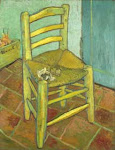
Claudia over at Museworthy has an interesting post today about artists' palettes, including photographs of palettes used by painters at one of the venues where she models. I thought I'd chime in with a photograph of a palette allegedly used by Vincent in June 1890 to paint a portrait of Dr. Paul Gachet's daughter, Marguerite, seated at her piano (see an image here). According to Dr. Gachet's son (also named Paul), Vincent discovered when he began working at the doctor's house that he'd left his palette at the Auberge Ravoux, where he lived. Dr. Gachet lent Vincent one of his palettes to use instead (Gachet was an avid amateur artist), and the palette remained in the Gachet family's possession ever since. Paul Gachet fils donated it to the French state as a "souvenir" of van Gogh when the state acquired the remaining paintings of the Gachet collection. Today it belongs to the Musée d'Orsay and is seldom put on display.
The conservators of the Musée d'Orsay, in preparation for the major 1999 exhibition about the Gachet collection (which was also shown at the Met), analyzed under electron microscope samples of the paints on the palette, as well as paint from six van Goghs formerly in the Gachet collection (now in the Orsay), and a tube of geranium lake pigment said by Paul Gachet fils to have been Vincent's. (They were not able to analyze the pigments used in "Marguerite Gachet at the Piano," because that painting is in the Kunstmuseum Basel.) They were particularly interested in the reds/pinks used by van Gogh; the pink colors on the palette are more vivid than the pinks in the paintings. The conservators determined that the tin carmine lake pigment used by Vincent in the paintings has faded over time, sometimes extensively. So Marguerite Gachet's dress was probably a much deeper rose than it is now, which makes sense because Vincent describes the dress as such in a letter to Theo. In the same way, "The Church at Auvers"originally had much more pink in the foreground, which again Vincent himself says, referring in a description for Theo to "sand with the pink glow of sunshine on it." The red pigments Vincent used while living in Auvers-sur-Oise were simply not stable. Which of course makes us wonder how many of Vincent's other paintings were originally even brighter than they are now? [For more about this, see J.-P. Rioux, "The Discoloration of Pinks and Purples in Van Gogh's Paintings from Auvers" in A. Distel and S.A. Stein, "Cézanne to Van Gogh: The Collection of Doctor Gachet," Metropolitan Museum 1999, pp. 104–113.]
Claudia refers in her post to the individuality of each artist's palette and the fact a palette can say something about them. If Vincent did use this palette as the Gachets claimed, don't you think it says something about his personality and working method? I see restlessness and impatience to keep moving, myself. Not necessarily "frenzy"--because although Vincent worked quickly, he worked with deliberation and forethought. But certainly a lack of tidiness, which Vincent was apparently known for. Paul Gauguin complained in his autobiography about the haphazard state of VIncent's Arles studio, and Vincent's lack of housekeeping skills seems to have caused friction when he was living with the more fastidious Theo.
The Musée Marmottan in Paris has one of Claude Monet's palettes on display. He was much more tidy!






2 comments:
Fascinating, Sheramy. An incredible read, and far more informative and eloquent than mine! It's a wonderful subject, and how incredible would it be to see that palette of Vincent's in person? His brushes and knives too. It's hard to top Van Gogh when it comes to pigments and strokes.
Thanks for expanding on the topic! I enjoyed it immensely :-)
Claudia
Thanks, Claudia! I've not seen the palette in person, myself: I saw the exhibition that I refer to in the post, but I don't remember seeing the palette. I'm not sure if it was in the show or not. It was so ridiculously crowded the day I went, I just missed it if it was. I've seen Monet's at the Musee Marmottan, and that was a thrill in itself. There's an intimacy, I think, to seeing the actual tools used by an artist one admires.
Post a Comment